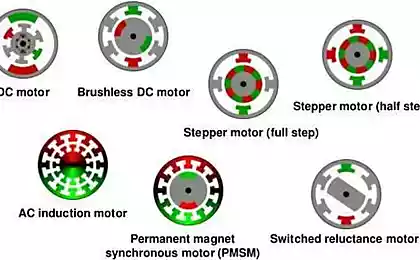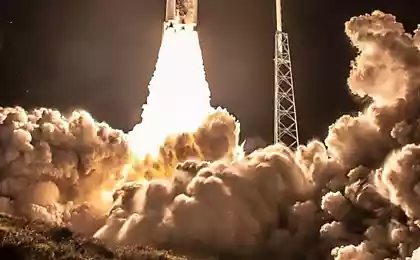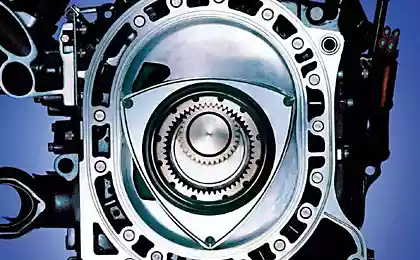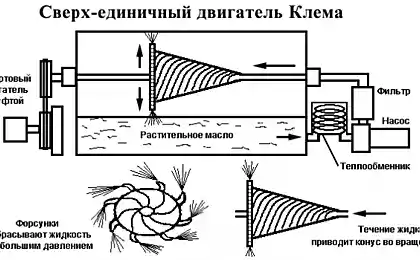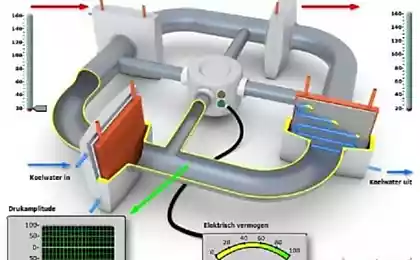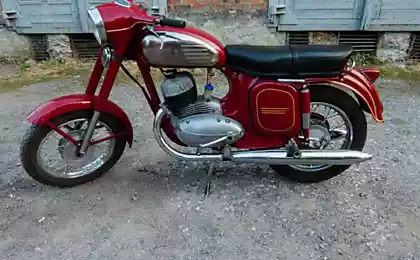243
Miniature motor for interplanetary missions
Key elements of the new engine built on the technology of microelectromechanical systems, and therefore can be mass-produced and inexpensive.
Economical drive for small satellites will allow them to turn into interplanetary station capable of autonomous flight to the moon, asteroids or Mars. Due to the cheapness of such devices may revolutionize space exploration.
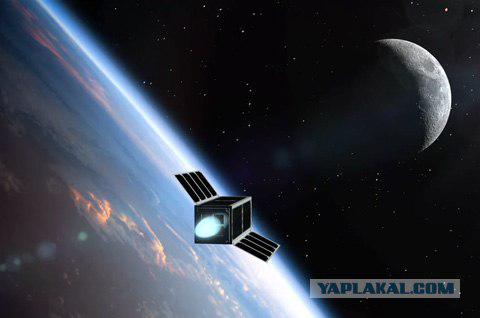
Engineers at the Polytechnic School of Lausanne (EPFL) built a prototype ion engine, called MicroThrust. It is designed for spacecraft weight from 1 to 100 kilograms. Such devices are often created at universities and institutes, usually run as cheap a passing load with larger satellites. At the same time the kids are still in the orbit to which they gave a booster.
But imagine what would increase the chances of scientists, if cheap "scouts" could themselves scatter the solar system without the need for major boosters or in association with rare and expensive flagship interplanetary missions.
The main idea of the project: the release of pico and nano-satellites from the shackles of Earth orbit (Figure EPFL).
In the development of ultra-compact drive in addition to the EPFL Space as a leading organization Priman attended a number of institutions and companies in the UK, the Netherlands and Sweden. Scientists and engineers have created several models and models, and recently were born the first working model of the engine MicroThrust.
This engine weighs less than 200 grams, including the control electronics, and even fuel (about 100 g). It can be easily integrated into the satellite measures just 10 x 10 x 10 centimeters, and it's a well-known and increasingly popular format CubeSat.
The new engine, Europeans also called "electrospray". Its principle is simple. The high voltage applied between the capillary and the electrode, the ionic liquid makes a cone shape, the end of which field pulls the individual ions. Additional overclocking electrode (not shown) can significantly increase the speed of the particles (Figure EPFL).
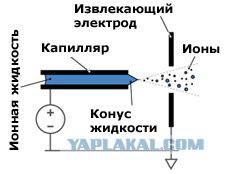
The stock of the working fluid in MicroThrust is not gas and an ionic liquid. This engine also differs from its predecessors. The authors chose the structure of the device EMI-BF4, used in a number of areas of technology as an electrolyte.
During operation of the device, this liquid due to capillary forces flows into microscopic silicon nozzle. Over thousands of holes per square centimeter are located on the surface of the tiny chips that make up the heart of the engine.
At the end of the nozzle ions are extracted from the liquid due to a strong electric field. For his generation chips equipped with electrodes grilles. These voltage is applied to the four thousand volts.
Driving trends. The basis of the device are microarrays with thousands of nozzles, capillaries (upper right). Each such nozzle (bottom) is directly connected to a fuel tank comprising an ionic liquid. To the right of the capillary visible extracts and accelerating electrodes. Top left shows one of the satellites, which can be applied in the new ion engine (illustration EPFL).
Ions leave the chips with speeds up to 10 km / s, creating a thrust of up to 100 mikronyutonov (with specific impulse of about 3,000 seconds). In this field polarity changes every second, so that the formation of the jet in the new design uses both positive and negative ions.
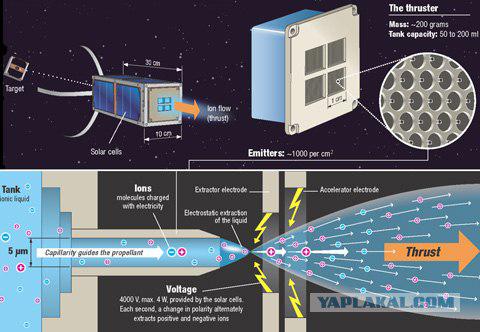
Experienced chips to one and nineteen capillaries under a microscope. Ready devices are squares with side 1 cm (picture EPFL).
Although the work of this engine requires a high voltage, energy consumed it more than modest. MicroThrust able to meet the capabilities of a typical small solar nano-satellite as consumes less than 4 watts of power.
Acceleration, developed by such devices is very small. But six months of the device MicroThrust only 100 milliliters of fuel can move a 10-inch satellite from Earth orbit to the Moon, according to the authors of the project. The rate of such a "researcher" will be gradually increased from the initial 6, 7 and 11, 7 km / s.
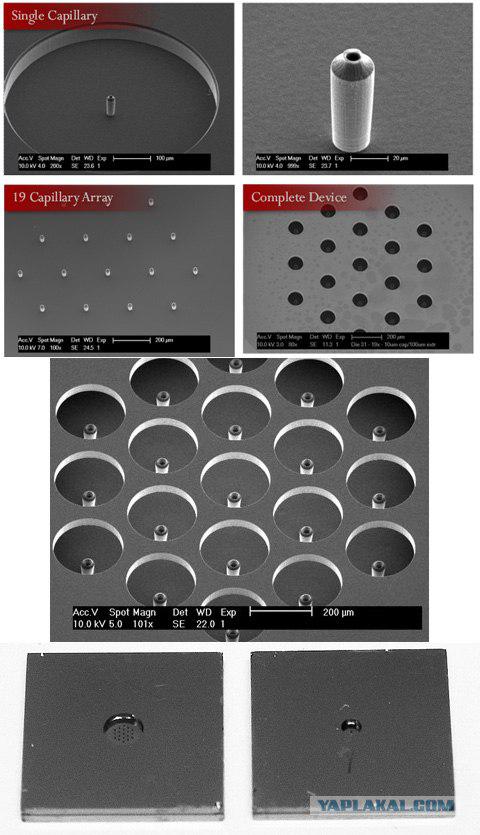
Trial grill with 19 nozzles was tested in a vacuum chamber (photos EPFL).
Now European scientists involved in fine-tuning the design of the engine. According to them, debugging and testing will go for another year. And already known pilot mission, which will be used by the new drive.
Firstly, we are talking about orbital scavengers CleanSpace One, be established in EPFL. And secondly, the device must be installed MicroThrust satellites Dutch project OLFAR. The latter provides for the deployment of distance from the Earth of a swarm of nano-satellites. Together, they form a low-frequency radio telescope with an aperture of tens of kilometers.
Posted in [mergetime] 1333454173 [/ mergetime]
Swiss indicate that the launch of the device CleanSpace One could take place in three years to four, and the project should be implemented OLFAR for a decade.
ALL. Thank you for your attention.
source
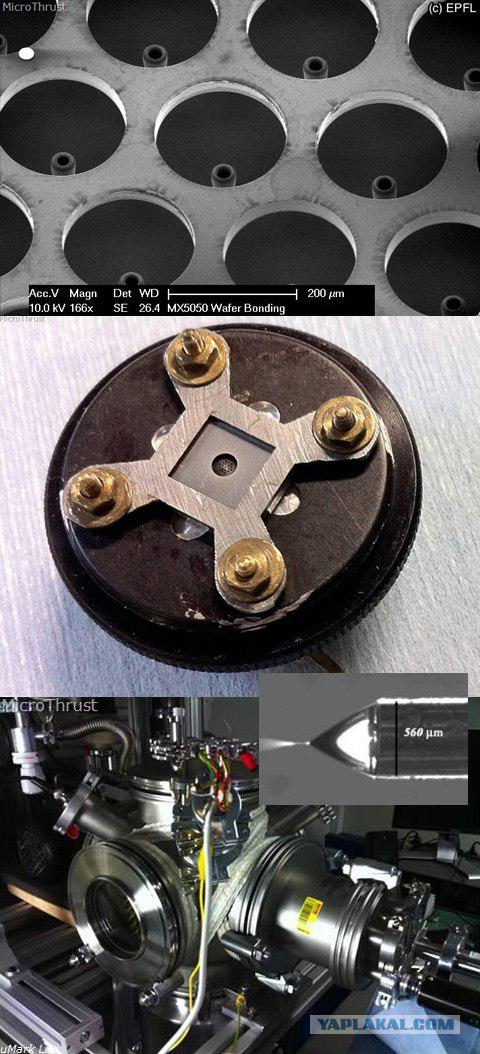
Source:
Economical drive for small satellites will allow them to turn into interplanetary station capable of autonomous flight to the moon, asteroids or Mars. Due to the cheapness of such devices may revolutionize space exploration.

Engineers at the Polytechnic School of Lausanne (EPFL) built a prototype ion engine, called MicroThrust. It is designed for spacecraft weight from 1 to 100 kilograms. Such devices are often created at universities and institutes, usually run as cheap a passing load with larger satellites. At the same time the kids are still in the orbit to which they gave a booster.
But imagine what would increase the chances of scientists, if cheap "scouts" could themselves scatter the solar system without the need for major boosters or in association with rare and expensive flagship interplanetary missions.
The main idea of the project: the release of pico and nano-satellites from the shackles of Earth orbit (Figure EPFL).
In the development of ultra-compact drive in addition to the EPFL Space as a leading organization Priman attended a number of institutions and companies in the UK, the Netherlands and Sweden. Scientists and engineers have created several models and models, and recently were born the first working model of the engine MicroThrust.
This engine weighs less than 200 grams, including the control electronics, and even fuel (about 100 g). It can be easily integrated into the satellite measures just 10 x 10 x 10 centimeters, and it's a well-known and increasingly popular format CubeSat.
The new engine, Europeans also called "electrospray". Its principle is simple. The high voltage applied between the capillary and the electrode, the ionic liquid makes a cone shape, the end of which field pulls the individual ions. Additional overclocking electrode (not shown) can significantly increase the speed of the particles (Figure EPFL).

The stock of the working fluid in MicroThrust is not gas and an ionic liquid. This engine also differs from its predecessors. The authors chose the structure of the device EMI-BF4, used in a number of areas of technology as an electrolyte.
During operation of the device, this liquid due to capillary forces flows into microscopic silicon nozzle. Over thousands of holes per square centimeter are located on the surface of the tiny chips that make up the heart of the engine.
At the end of the nozzle ions are extracted from the liquid due to a strong electric field. For his generation chips equipped with electrodes grilles. These voltage is applied to the four thousand volts.
Driving trends. The basis of the device are microarrays with thousands of nozzles, capillaries (upper right). Each such nozzle (bottom) is directly connected to a fuel tank comprising an ionic liquid. To the right of the capillary visible extracts and accelerating electrodes. Top left shows one of the satellites, which can be applied in the new ion engine (illustration EPFL).
Ions leave the chips with speeds up to 10 km / s, creating a thrust of up to 100 mikronyutonov (with specific impulse of about 3,000 seconds). In this field polarity changes every second, so that the formation of the jet in the new design uses both positive and negative ions.

Experienced chips to one and nineteen capillaries under a microscope. Ready devices are squares with side 1 cm (picture EPFL).
Although the work of this engine requires a high voltage, energy consumed it more than modest. MicroThrust able to meet the capabilities of a typical small solar nano-satellite as consumes less than 4 watts of power.
Acceleration, developed by such devices is very small. But six months of the device MicroThrust only 100 milliliters of fuel can move a 10-inch satellite from Earth orbit to the Moon, according to the authors of the project. The rate of such a "researcher" will be gradually increased from the initial 6, 7 and 11, 7 km / s.

Trial grill with 19 nozzles was tested in a vacuum chamber (photos EPFL).
Now European scientists involved in fine-tuning the design of the engine. According to them, debugging and testing will go for another year. And already known pilot mission, which will be used by the new drive.
Firstly, we are talking about orbital scavengers CleanSpace One, be established in EPFL. And secondly, the device must be installed MicroThrust satellites Dutch project OLFAR. The latter provides for the deployment of distance from the Earth of a swarm of nano-satellites. Together, they form a low-frequency radio telescope with an aperture of tens of kilometers.
Posted in [mergetime] 1333454173 [/ mergetime]
Swiss indicate that the launch of the device CleanSpace One could take place in three years to four, and the project should be implemented OLFAR for a decade.
ALL. Thank you for your attention.
source

Source:




